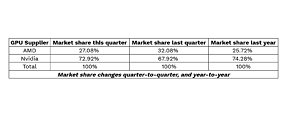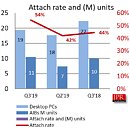Friday, November 29th 2019
Jon Peddie Research: Global Q3'19 add-in board market soars led by Nvidia
The add-in board market increased in Q3'19 by 42% from last quarter, with over $2.8 billion dollars of AIBs shipped. Nvidia increased its market share to 73% in Q3. The last fiscal quarter was transitional for Nvidia as older products made their way through the channel allowing the company to ramp up production and ship more new products at the end of the quarter. Nvidia not only boosted their market share but they raised the overall AIB market. Their channel inventory is now reported as healthy says the company. Nvidia's RTX line is doing well and represents 66% of its gaming revenue.
Quarter-to-quarter graphics add-in board shipments increased by 42.2% and increased by 6.2% year-to-year. The market shares for the desktop discrete GPU suppliers shifted in the quarter, Nvidia significantly increased market share from last quarter, while AMD increased share year-over-year.Add-in boards (AIBs) using discrete GPUs are found in desktop PCs, workstations, servers, rendering and mining farms, and other devices such as scientific instruments. They are sold directly to customers as aftermarket products or are factory installed by OEMs. In all cases, AIBs represent the higher end of the graphics industry with their discrete chips and dedicated, often large, high-speed memory. Systems with integrated GPUs in CPUs share slower system memory.
The PC AIB market now has just two chip (GPU) suppliers which also build and sell AIBs. The primary suppliers of GPUs are AMD and Nvidia. There are 54 AIB suppliers. They are the AIB OEM customers of the two major GPU suppliers, which they call partners. Some of the AIB suppliers offer AMD and Nvidia-based products, and others offer only one or the other.
In addition to privately branded AIBs offered worldwide, about a dozen PC suppliers offer AIBs as part of a system, and/or as an option, and some offer AIBs as separate aftermarket products. We have been tracking quarterly AIB shipments since 1987—the volume of those boards peaked in 1999, reaching 114 million units when every PC had a graphics AIB in them. This quarter 10.5 million AIBs shipped.
The AIB market hit $15 billion last year and is forecasted to be $15 billion by 2023.
Since 1981, 1,299 million AIBs have been shipped.
The third quarter is normally the strongest from the previous quarter. This quarter it was up 42.2% from the last quarter. That is above the ten-year average of 14.9% which is unusually high when compared to the desktop PC market, which increased 9.6% from the last quarter.On a year-to-year basis, we found that total AIB shipments during the quarter rose 6.2%, which is greater than desktop PCs, which fell -15.9% from the same quarter a year ago. Overall, AIBs shipments had been declining slightly, but not as great as the PC due to gaming. However, in 2015 when the use of AIB for cryptocurrency mining became widespread, AIB sales started to rise while PC sales fell.
Despite the overall PC churn, somewhat due to tablets and embedded graphics, the PC gaming momentum continues to build and is the bright spot in the AIB market. The impact and influence of eSports has also contributed to market growth and has attracted new users. VR continues to be interesting but is not having a measurable influence on the AIB market.
Quarter-to-quarter graphics add-in board shipments increased by 42.2% and increased by 6.2% year-to-year. The market shares for the desktop discrete GPU suppliers shifted in the quarter, Nvidia significantly increased market share from last quarter, while AMD increased share year-over-year.Add-in boards (AIBs) using discrete GPUs are found in desktop PCs, workstations, servers, rendering and mining farms, and other devices such as scientific instruments. They are sold directly to customers as aftermarket products or are factory installed by OEMs. In all cases, AIBs represent the higher end of the graphics industry with their discrete chips and dedicated, often large, high-speed memory. Systems with integrated GPUs in CPUs share slower system memory.
The PC AIB market now has just two chip (GPU) suppliers which also build and sell AIBs. The primary suppliers of GPUs are AMD and Nvidia. There are 54 AIB suppliers. They are the AIB OEM customers of the two major GPU suppliers, which they call partners. Some of the AIB suppliers offer AMD and Nvidia-based products, and others offer only one or the other.
In addition to privately branded AIBs offered worldwide, about a dozen PC suppliers offer AIBs as part of a system, and/or as an option, and some offer AIBs as separate aftermarket products. We have been tracking quarterly AIB shipments since 1987—the volume of those boards peaked in 1999, reaching 114 million units when every PC had a graphics AIB in them. This quarter 10.5 million AIBs shipped.
The AIB market hit $15 billion last year and is forecasted to be $15 billion by 2023.
Since 1981, 1,299 million AIBs have been shipped.
The third quarter is normally the strongest from the previous quarter. This quarter it was up 42.2% from the last quarter. That is above the ten-year average of 14.9% which is unusually high when compared to the desktop PC market, which increased 9.6% from the last quarter.On a year-to-year basis, we found that total AIB shipments during the quarter rose 6.2%, which is greater than desktop PCs, which fell -15.9% from the same quarter a year ago. Overall, AIBs shipments had been declining slightly, but not as great as the PC due to gaming. However, in 2015 when the use of AIB for cryptocurrency mining became widespread, AIB sales started to rise while PC sales fell.
Despite the overall PC churn, somewhat due to tablets and embedded graphics, the PC gaming momentum continues to build and is the bright spot in the AIB market. The impact and influence of eSports has also contributed to market growth and has attracted new users. VR continues to be interesting but is not having a measurable influence on the AIB market.


27 Comments on Jon Peddie Research: Global Q3'19 add-in board market soars led by Nvidia
Why would AMD market share be 32 at first place, this doesn't make sense at all
JPR blacklisted!
This part alone is enough to show how bullshet this "report" is:
"The last fiscal quarter was transitional for Nvidia as older products made their way through the channel allowing the company to ramp up production and ship more new products at the end of the quarter. Nvidia not only boosted their market share but they raised the overall AIB market. Their channel inventory is now reported as healthy says the company. Nvidia's RTX line is doing well and represents 66% of its gaming revenue"
I don't think amd's revenue increases that much when they launch something new.more like when they put something on sale.then sales go through the roof for a couple of weeks.
Even though RX 5700 is doing okay, it's still not changing the game.
Steam hardware survey:
It's not that long ago that several of the YouTubers often mentioned here in the forums (I will not name them, but you know who) claimed that Navi will crush Nvidia, but once again they're lagging behind. This is sad because we need some real competition in the graphics market, and this is simply not good enough. Nvidia is probably launching their next generation "soon", and I seriously hope that AMD have something better than recycled Navi by then.
intel was so dominant cause it was pitted against wack amd cpus.once they got their stuff together it turned out intel is losing ground fast.
but nvidia is able to dominate against good amd cards.in gpu market faster in gaming means everything.nobody buys these for productivity.
The most scary part of all this is that Nvidia is crushing the market despite RTX being in its infancy stage and despite the inferior lithography . Next year Nvidia is moving to 7nm EUV which will allow them to extend even further their lead in performance and efficiency and at the same time refine the ray-tracing aspect , meanwhile AMD has yet to catch-up 1080Ti perf ...... let that idea sink in for a moment .
Imagine the effects we'll see when increased R&D budget of the graphics department will kick in.You know, perhaps AMD PR guy pissing on steam stats wasn't convincing enough, but after an independent source confirms steam survey is shite, it's perhaps time to at least have some doubts about it?
Report says: AMD market share last year 25.72%, AMD market share this quarter 27.08%. Medi reads: "AMD managed to grab GPU market share". I mean, it did, technically, but we're now raving at less than 1.5%? :wtf: